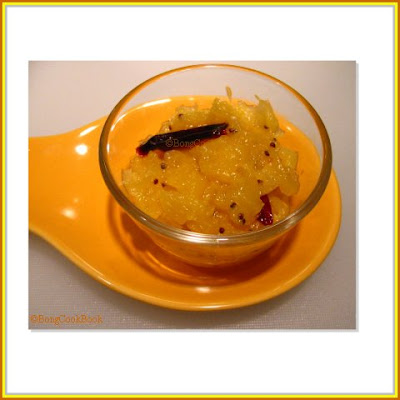"I se Imli" for Nupur’s A-Z of Indian Vegetables this week!!! Imli or Tamarind or Tetul is not an integral part of Bengali cooking. If you knock at my doors on a random Tuesday and ask me for some Tamarind, you will have to go back home disgruntled as I generally don’t have any. But since I like sambhar I get some Tamarind paste off and on, so you still might knock and get lucky.
Tamarind however plays a special and coveted role when it comes to “tak” or “chaatni” for Bengalis. Ripe Tamarind mixed with little mustard oil, salt, sugar and a bit of chilli powder (the concoction commonly known as “Makha Tetul”) on a summer afternoon was something we used to drool over as kids and were allowed to have only occasionally. At my Mamarbari (maternal grandparents house) my Ma’s cousin sisters would make this and we would quietly devour it at the corner of the roof on a hot summer afternoon.
We also use Tamarind for making chutney or achaar but they are rarely if ever used in cooking.
I was pleasantly surprised when I saw “Ka(n)cha Tetul” or “Raw Tamarind” in my Indian Grocery store. Visions of “Tetul er tak” a light chaatni made with Tamarind mesmerized me and I brought them home. My Ma suggested we pair these up with Raw Green Papaya to make a chaatni and that is what I did. So heres "Pepe Tetul er Chaatni" or "Green Papaya and Tamarind Chutney". We usually have this chutney with lunch or dinner. Its sweet and sour with the Tamarind and little crunchy with the Papaya.
Read more...
What You Need
Serves 4
Papaya ~ 1 cup. Unripe Green Papaya peeled and thinly sliced 1 cup. When you cut raw papaya make sure to peel the skin, and when you reach the part which has the white seeds remove the seeds. You should also remove the little hard skin at the centre
Unripe Raw Tamarind ~ 6 cut in halves. Remove the ends and then cut them in halves or more for bigger ones
Mustard seeds ~ ½ tsp
Sugar ~ Started with 1/4 cup but was a little too sour for us so added 1/6 cup more
Ginger Juice ~ 1 tsp
Salt
Oil
Water
How I Did It
Pressure cook the papaya slices. Take care that they are just cooked and not very soft. I put them in a separator in my pressure cooker and put water only at the bottom of the cooker, none in the separator. If you want you can do away with this step and cook it later too, I wanted it quick so I pressure cooked.
Soak the halved tamarinds in water
Heat Oil
Add mustard seeds
As soon as they sputter add the tamarind
Saute for couple of minutes and add the papaya.
Add salt, water and let it cook. Add water depending on how thick you want your chutney to be.
When the tamarind has become soft add the sugar and the ginger juice
Let it cook and the chaatni thicken to your desired consistency. Usually I don't have it very thick
Tip: When you are cutting raw papaya make sure that you remove the seeds and the hard skin next to the skin at the core. I don't know what it is called but if not removed the papaya may taste bitter when cooked. This is for dear Sushma's MTC -- Monthly Cooking Tipology . Check details at her blog Recipe Source
Safety Moment: Women in India and South East Asia and other parts of the world have used papaya for contraception and abortion since long and this is proven by Medical research so be careful to have Papaya when you are expecting. Though small amounts of ripe papaya does not cause any harm check with your doctor for authenticity as I do not know more about this effect. This is for lovely Jyotsna's event Safety Moment. Check more at her blog CurryBazaar
Trivia:Women in India and South East Asia and other parts of the world have used papaya for contraception and abortion since long and this is proven by Medical research so be careful to have Papaya when you are expecting.Papaya is rich in an enzyme called papain and other proteins and used as a digestive medicine (Source: Wiki)








